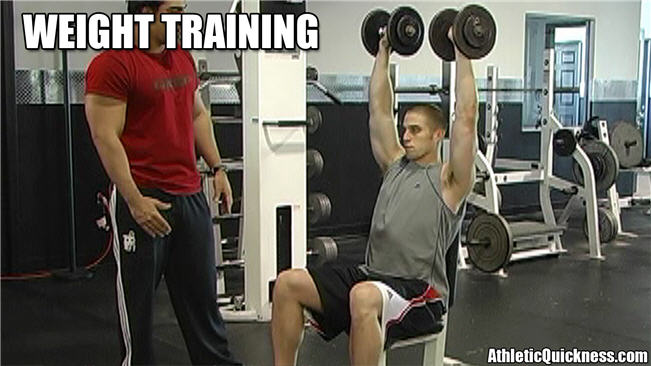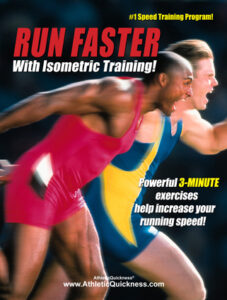The 3 Types of Muscle Contractions Concentric, Eccentric, and Isometric
Your speed training program will deliver your best sports performance when you train your muscles with all three!
Part 2 of 4 – Weight Lifting
Part 1 – Muscle Contraction Types
This section describes several different types of weight lifting exercises and defines which types of muscle contractions are involved in the exercise, and explains why that exercise is important to overall athletic performance.
Weight Lifting
Weight lifting, otherwise known as strength training, forms the foundation of most sports training exercise programs. No training would be considered complete without a solid strength training schedule. Weight training helps increase strength, and strength helps to overcome resistance, carry your body weight more efficiently, and prevent injury.
Having enough muscle strength to perform a sports skill, such as running, jumping or swinging a bat, though critical to better performance, is rarely sufficient to maximize one’s athletic performance, yet is often over emphasized in relation to the types of training exercises.
Weight lifting exercises often target individual muscles used to flex or extend a joint. It is important, therefore to balance a weight lifting routine with several exercises so that all of the muscles and joints in a sports skill are trained proportionally.
Examples of weight lifting exercises:
Biceps Curl
During flexion of the elbow, the biceps muscle contracts or shortens and therefore undergoes a concentric muscle contraction.
During the return of the weight back towards your waistline, the biceps muscle lengthens, while undergoing tension. This is an eccentric contraction.
Unless the weight is dropped after the targeted muscle contracts, there will always be an eccentric muscle contraction that follows after the concentric contraction. This is true with all weight training.
Triceps Push Down (using a bar attached to a cable and pulley machine)
During extension of the elbow, the triceps muscle contracts or shortens and therefore undergoes a concentric muscle contraction.
During the return of the weight back to the stack of weights, the triceps muscle lengthens while undergoing tension. This is an eccentric contraction.
Again, unless the weight or bar is released after the targeted muscle contracts, there will always be an eccentric muscle contraction that follows after the concentric contraction.
Leg Extensions (performed on a seated leg extension machine)
With your knees flexed, and your ankles placed behind the bar, you extend your knee, also known as leg extension. The quadriceps muscle is responsible for this motion and during the extension of the knee, the quadriceps muscle shortens, which is an eccentric muscle contraction.
When the weight is returned, the quadriceps muscle still undergoes tension, but in the opposite direction. The quadriceps muscle lengthens in the process. This is an eccentric muscle contraction.
Leg Curls (performed on a prone leg curl machine)
While you are on your stomach and the back of your ankles are placed under the bar, you flex your knee. This is also known as leg flexion or leg curls. The hamstring muscles are primarily responsible for this motion. During flexion of the knee, the hamstring muscles shorten. This is a concentric muscle contraction.
When the weight is returned, the hamstring muscles still undergo tension but in the opposite direction. The hamstrings lengthen during this process. This is an eccentric muscle contraction.
Other types of weight lifting exercises use body weight for resistance, such as pull-ups and push-ups.
Again, these concentric (shortening) and eccentric (lengthening) muscle contractions are common with most weight lifting exercises, but the concentric (shortening) contractions are the primary contraction type found in weight lifting.
Some exceptions would be when an athlete, such as an Olympic power-lifter, raises the weight over their head and then drops it to the ground. This would be an example of when concentric muscle contractions are taking place with respect to your chest, shoulders, and triceps.
Another example would be when you are performing bench presses, but instead of pressing the weight up from your chest, your spotters hand you a much heavier weight than you normally use, and you slowly lower it to your body. This is an example of an eccentric (lengthening) muscle contraction with respect to your chest and triceps muscles.
Always glad to help!
Dr. Larry Van Such
Part 1 – Muscle Contraction Types






